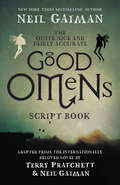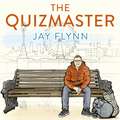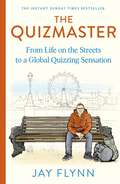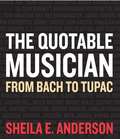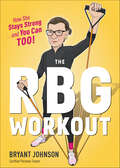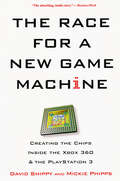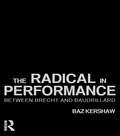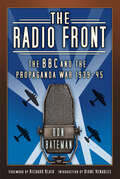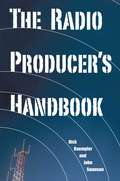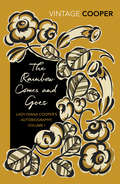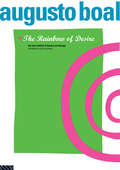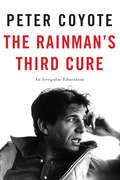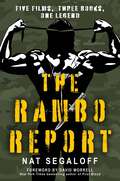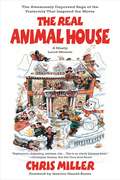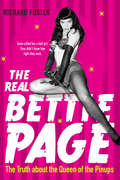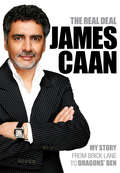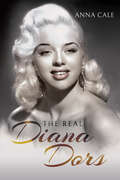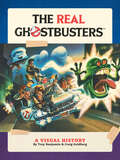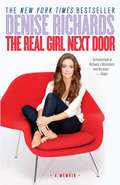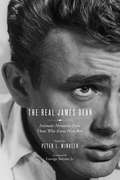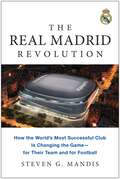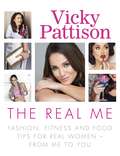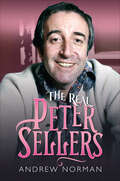- Table View
- List View
The Quite Nice and Fairly Accurate Good Omens Script Book: The Script Book
by Neil GaimanNeil Gaiman’s complete original scripts for the highly anticipated six-episode original series, adapted from the classic novel he wrote with Terry Pratchett.First published nearly thirty years ago, the novel Good Omens has sold more than five million copies worldwide and is beloved by Gaiman and Pratchett fans alike. Collected here are Neil Gaiman’s original scripts for the Good Omens television series, offering readers deeper insight into Gaiman’s brilliant new adaptation of a masterwork.A tale of good and evil and the end of the world, Good Omens stars Michael Sheen as the angel Aziraphale; David Tennant as the demon Crowley; and Jon Hamm as the archangel Gabriel, as well as Anna Maxwell Martin, Josie Lawrence, Adria Arjona, Michael McKean, Jack Whitehall, Miranda Richardson, and Nick Offerman.
The Quizmaster: From Life on the Streets to a Global Quizzing Sensation
by Jay Flynn** Available to pre-order now **THE HEART-WARMING, REMARKABLE TRUE STORY OF THE QUIZMASTER JAY FLYNN, WHOSE VIRTUAL PUB QUIZ BECAME AN ONLINE SENSATION DURING COVID.Jay Flynn was down on his luck when the Covid pandemic struck. He had just lost the tenancy of the pub he ran in Lancashire - and with it the loyal community of locals who loved his quirky weekly quiz.As the world closed down, he sensed the quiz could now be a lifeline both for him and the locals - so he sent them invites to an online version. But he had forgotten to mark the event 'private', and on the night, a disbelieving Jay played quizmaster to half a million teams, from Kenya to Canada, New Zealand to the Ukraine. This was to be the start of a global online quiz sensation, earning more than £1 million for charity and Jay an MBE, as well as his own slot on Zoe Ball's BBC Radio 2 Breakfast Show.It was all the more incredible because, as a lost and troubled young man, Jay had spent two years homeless, sleeping on a bench on the Embankment in London, almost taking his own life. Rescued by a homeless charity, he'd learnt how a simple community can save lives. It proved a priceless lesson.Now, in his inspiring memoir, Jay shows how, sometimes, you can find the answers you're seeking in the most unexpected places.
The Quizmaster: From Life on the Streets to a Global Quizzing Sensation
by Jay Flynn** Available to pre-order now **THE HEART-WARMING, REMARKABLE TRUE STORY OF THE QUIZMASTER JAY FLYNN, WHOSE VIRTUAL PUB QUIZ BECAME AN ONLINE SENSATION DURING COVID.Jay Flynn was down on his luck when the Covid pandemic struck. He had just lost the tenancy of the pub he ran in Lancashire - and with it the loyal community of locals who loved his quirky weekly quiz.As the world closed down, he sensed the quiz could now be a lifeline both for him and the locals - so he sent them invites to an online version. But he had forgotten to mark the event 'private', and on the night, a disbelieving Jay played quizmaster to half a million teams, from Kenya to Canada, New Zealand to the Ukraine. This was to be the start of a global online quiz sensation, earning more than £1 million for charity and Jay an MBE, as well as his own slot on Zoe Ball's BBC Radio 2 Breakfast Show.It was all the more incredible because, as a lost and troubled young man, Jay had spent two years homeless, sleeping on a bench on the Embankment in London, almost taking his own life. Rescued by a homeless charity, he'd learnt how a simple community can save lives. It proved a priceless lesson.Now, in his inspiring memoir, Jay shows how, sometimes, you can find the answers you're seeking in the most unexpected places.
The Quizmaster: From Life on the Streets to a Global Quizzing Sensation
by Jay Flynn** Available to pre-order now **THE HEART-WARMING, REMARKABLE TRUE STORY OF THE QUIZMASTER JAY FLYNN, WHOSE VIRTUAL PUB QUIZ BECAME AN ONLINE SENSATION DURING COVID.Jay Flynn was down on his luck when the Covid pandemic struck. He had just lost the tenancy of the pub he ran in Lancashire - and with it the loyal community of locals who loved his quirky weekly quiz.As the world closed down, he sensed the quiz could now be a lifeline both for him and the locals - so he sent them invites to an online version. But he had forgotten to mark the event 'private', and on the night, a disbelieving Jay played quizmaster to half a million teams, from Kenya to Canada, New Zealand to the Ukraine. This was to be the start of a global online quiz sensation, earning more than £1 million for charity and Jay an MBE, as well as his own slot on Zoe Ball's BBC Radio 2 Breakfast Show.It was all the more incredible because, as a lost and troubled young man, Jay had spent two years homeless, sleeping on a bench on the Embankment in London, almost taking his own life. Rescued by a homeless charity, he'd learnt how a simple community can save lives. It proved a priceless lesson.Now, in his inspiring memoir, Jay shows how, sometimes, you can find the answers you're seeking in the most unexpected places.
The Quotable Musician: From Bach to Tupac
by Sheila E. AndersonFor those looking for a little more from musicians and composers than music here are quotations of wit and wisdom, anger and admission. Material is divided into 30 topics such as identity, humor, conducting, other musicians, wisdom, and society. Also featured are short interviews with Ron Carter, a discussion about Thelonious Sphere Monk with his son, and Benny Golson. Musicians and composers run the genre gamut, with jazz, classical, and popular musics featured most predominantly. Anderson is the host of Sunday Morning Harmony on WBGO in Newark. The book is geared to a popular readership. Annotation (c)2003 Book News, Inc. , Portland, OR (booknews. com)
The RBG Workout: How She Stays Strong . . . and You Can Too!
by Bryant JohnsonA fun, fully illustrated exercise book that details Ruth Bader Ginsburg’s workout, written by her trainer.A Supremely Good Exercise Program!How does Justice Ruth Bader Ginsburg, one of the Supreme Court’s favorite octogenarians, stay so active and energetic? She owes it in part to the twice-weekly workouts she does with her personal trainer, Bryant Johnson, a man she’s called “the most important person” in her life (after her family, of course). Now, with The RBG Workout, you can exercise alongside Justice Ginsburg and Bryant. Whether you want to keep up with one of America’s most admired women or just reach your own fitness goals, this book is for you. Case closed.
The Race For A New Game Machine:
by David Shippy Mickie PhippsThe pioneering game-chip engineers behind the revolutionary Cell microprocessor tell the story of its creation in this &“fast-paced tell-all&” (Steve Cherry, IEEE Spectrum Magazine). The Xbox 360 and PlayStation 3 game systems have changed the face of home entertainment. But few know the amazing story inside the consoles—how David Shippy and his team of engineers at the Sony/Toshiba/IBM Design Center (STI) forged the tiny miracle at the core of it all: a revolutionary microprocessor chip that set a new paradigm in personal computing. In The Race for a New Gaming Machine, Shippy tells the dramatic story in his own words. Here is a dazzling, behind-the-scenes account of life in the tech world, featuring memorable characters, high-level corporate intrigue, and cutthroat business dealings. At stake were the livelihoods—and sanity—of an unsung group of tireless visionaries. At war were the giants Microsoft and Sony. It's a story that's never been told—until now.
The Radical in Performance: Between Brecht and Baudrillard
by Baz KershawThe Radical in Performance investigates the crisis in contemporary theatre, and celebrates the subversive in performance. It is the first full-length study to explore the link between a western theatre which, says Kershaw, is largely outdated and the blossoming of postmodern performance, much of which has a genuinely radical edge. In staying focused on the period between Brecht and Baudrillard, modernity and postmodernism, Baz Kershaw identifies crucial resources for the revitalisation of the radical across a wide spectrum of cultural practices. This is a timely, necessary and rigorous book. It will be a compelling read for anyone searching for a critical catalyst for new ways of viewing and practising cultural politics.
The Radio Front: The BBC and the Propaganda War 1939-45
by Ron BatemanWithin seventeen years of the first public broadcast in Britain, the nation again found itself at war. As the Second World War progressed, the BBC eventually realised the potential benefits of public radio and the service became vital in keeping an anxious public informed, upbeat and entertained behind the curtains of millions of blacked-out homes. The Radio Front examines just how the BBC reinvented itself and delivered its carefully controlled propaganda to listeners in the UK and throughout Nazi-occupied Europe. It also reveals the BBC’s often-strained relationships with the government, military and public as the organisation sought to influence opinion and safeguard public morale without damaging its growing reputation for objectivity and veracity.Using original source material, historian and author Ron Bateman tracks the BBC’s growth during the Second World War from its unorganised and humble beginnings to the development of a huge overseas and European operation, and also evaluates the importance of iconic broadcasts from the likes of J.B. Priestley, Vera Lynn and Tommy Handley.
The Radio Producer's Handbook
by John Swanson Rick KaempferTwo award-winning major market producers present the definitive how-to guide for producing a radio show, explaining every duty a radio producer is expected to perform. With refreshing honesty and the humorous flair of professional radio comedy writers, the authors reveal how to get one's professional foot in the radio door, book celebrity guests, craft great interviews, come up with ideas, create great phone segments, write and pitch material, and cope with the pressure that accompanies producing a show in progress.
The Ragman's Son: An Autobiography
by Kirk DouglasRaised in poverty, longing for his father's approval, Issur Danielovitch went on to become a legendary Hollywood star - Kirk Douglas. Here in his own words is the story of his life.
The Rainbow Comes and Goes
by Diana CooperLady Diana Cooper was a star of the early twentieth stage, screen and social scene. This first instalment of her sparkling autobiography tells of her upbringing, her beautiful artistic mother and aristocratic father, her debut into high society and the glittering parties - 'dancing and extravagance and lashing of wine, and charades and moonlit balconies and kisses' - which were interrupted with the outbreak of the First World War. This volume ends with Diana's marriage to the 'love of her life', diplomat and politician Duff Cooper.
The Rainbow of Desire: The Boal Method of Theatre and Therapy
by Augusto BoalRainbow of Desire is a handbook of exercises with a difference. It is Augusto Boal's bold and brilliant statement about the therapeutic ability of theatre to liberate individuals and change lives. Now translated into English and comprehensively updated from the French, Rainbow of Desire sets out the techniques which help us `see' for the first time the oppressions we have internalised. Boal, a Brazilian theatre director, writer and politician, has been confronting oppression in various forms for over thirty years. His belief that theatre is a means to create the future has inspired hundreds of groups all over the world to use his techniques in a multitude of settings. This, his latest work, includes such exercises as: * The Cops in the Head and their anti-bodies * The screen image * The image of the future we are afraid of * Image and counter-image ....and many more. Rainbow of Desire will make fascinating reading for those already familiar with Boal's work and is also completely accessible to anyone new to Theatre of the Oppressed techniques.
The Rainman's Third Cure: An Irregular Education
by Peter Coyote"The rainman gave me two curesAnd he said, 'Just jump right in.'The one was Texas MedicineAnd the other was railroad gin.And like a fool I mixed themAnd they strangled up my mindNow people just get uglierAnd I have no sense of time." --Bob Dylan, "Stuck Inside of Mobile with the Memphis Blues Again" The guiding metaphor in Peter Coyote's new spiritual biography is drawn from a line in an early Bob Dylan song. For Coyote, the twin forces Dylan identifies as Texas Medicine and Railroad Gin - represent the competing forces of the transcendental, inclusive, and ecstatic world of love with the competitive, status-seeking world of wealth and power. The Rainman's Third Cure is the tale of a young man caught between these apparently antipodal options and the journey that leads him from the privileged halls of power to Greenwich Village jazz bars, to jail, to the White House, lessons from a man who literally held the power of life and death over others, to government service and international success on stage and screen.Expanding his frame beyond the wild ride through the 1960's counterculture that occupied so much of his lauded debut memoir, Sleeping Where I Fall, Coyote provides readers intimate portraits of mentors that shaped him-a violent, intimidating father, a be-bop Bass player who teaches him that life can be improvised, a Mafia consiglieri, who demonstrates to him that men can be bought and manipulated, an ex game-warden who initates him into the laws of nature, a gay dancer in Martha Graham's company who introduces him to Mexico and marijuanas, beat poet Gary Snyder, who introduces him to Zen practice, and finally famed fashion designer Nino Cerruti who made the high-stakes world of haute monde Europe available to him.What begins as a peripatetic flirtation with Zen deepens into a life-long avocation, ordination as a priest, and finally the road to Transmission---acknowledgement from his teacher that he is ready to be an independent teacher. Through Zen, Coyote discovers a third option that offers an alternative to both the worlds of Love and Power's correlatives of status seeking and material wealth. Zen was his portal, but what he discovers on the inside is actually available to all humans. In this energetic, reflective and intelligent memoir, The Rainman's Third Cure is the way out of the box. The way that works.
The Rambo Report: Five Films, Three Books, One Legend
by Nat SegaloffThe ultimate guide to the Rambo phenomenon—from bestselling novel to Hollywood blockbuster to all-American hero, legend, and icon—written with the full cooperation of Rambo&’s creator, bestselling author David Morrell . . . From the beginning, Rambo was more than a character in a 1972 novel by David Morrell. He was the culmination of the author&’s personal encounters with veterans returning from the Vietnam War. The 1982 movie adaptation of First Blood reflected the novel&’s powerful insights into a troubled veteran&’s postwar experience. Then in 1985, the film&’s explosive sequel Rambo: First Blood Part II transformed the character into something shockingly different. With a focus on blood-and-guts action—and the beefed-up muscles of Sylvester Stallone—Rambo became an invincible one-man army. A new kind of hero for a new day in America. A full-blown pop-culture icon as controversial as he was crowd-pleasing—blasting his way through the most influential action film franchise in Hollywood history . . . The Rambo legend was born. Five feature films. Three novels. Seven video games. Countless comic books, action figures, and even an animated TV show for kids. The Rambo machine has been as unstoppable as Rambo himself. Now for the first time, Hollywood insider Nat Segaloff digs deep into the man, the myth, and the massive impact of the phenomenon known as &“The Rambo Effect.&” Packed with behind-the-scenes anecdotes, sharp cultural insights, and ongoing debates about violence in the media, this is an explosive no-holds-barred report from the front lines of Hollywood mythmaking. A must-read for Rambo fans, movies buffs, and anyone interested in American culture . . .
The Real Animal House: The Awesomely Depraved Saga of the Fraternity That Inspired the Movie
by Chris Miller"Loud, raucous, infantile, racy, and very funny...The book is full of likable eccentrics, sexual shenanigans, and--if you know where to look for them--valuable life lessons."--Booklist Animal House, the movie, didn't tell the half of it. Writing with a freshness and joy that make Dartmouth 1960 feel like a beer-soaked rock-and-roll heaven on earth, Chris Miller tells the real story of the Alpha Delta Phi fraternity as no one else could. Seal, Doberman, Otter, the legendary Moses (he of the burning bush) - these titans and dozens of others come alive again, terrorizing the administration, taunting cops, surviving their own lunacy, and challenging the squareness of a stifling time. The Real Animal House is the perfect antidote for a conventional age much like today. "A breezy, chuckle-worthy read, and a must for the Animal House fan." -Courier-Post "Action-packed. . . . A boozy holler of a book, with a great soundtrack." -Kirkus Reviews "A seriously funny read. . . . The joy and exuberance that Pinto and his pals demonstrate holds a lesson for every generation that needs to learn not to blindly follow the expectations of parents and guidance counselors, but to seek out those blissful bands of merry misfits that appear from time to time." -Review
The Real Bettie Page: The Truth about the Queen of the Pinups
by Richard Foster“Scrupulously researched . . . An eloquent fan, Foster brings insight into Page’s recent revival as a sex symbol.” —Entertainment Weekly TWENTIETH ANNIVERSARY EDITION UPDATED BY THE AUTHOR WITH A NEW EPILOGUE She has been called the most photographed model in history. From her modest beginnings in Nashville to her legacy as a cult figure, here is the true story of America’s iconic pinup queen, legendary Playboy centerfold Bettie Page—including her stormy marriages, her trial for attempted murder, and her decade-long isolation in a California mental institution. During the 1950s, Bettie set hearts ablaze with her killer curves and girl-next-door smile. Yet at the height of her popularity, with a promising acting career before her, she walked away. For more than thirty years, Bettie stayed hidden from the public eye, though she lived on in her fans’ memories, much like Marilyn Monroe and James Dean. Journalist Richard Foster became the first reporter to contact Page during her long absence, and the first to tell her full story. Using interviews with those who knew her, and filled with uncommon knowledge and insights, The Real Bettie Page reveals both the fun flirt and fashion-forward counter-culture icon whose style continues to inspire today, as well as the intriguing and complex, flesh-and-blood woman behind her smiling photos. Includes classic and rare color and black-and-white photos
The Real Deal: My Story from Brick Lane to Dragons' Den
by James CaanAfter dropping out of school at just sixteen, James Caan started his business life in a broom cupboard with no qualifications and two pieces of fatherly wisdom: 'observe the masses and do the opposite' and 'always look for opportunities where both parties benefit'. Armed with this advice, natural charm and the Yellow Pages, he built a market-leading business with a turnover of £130 million and swiftly became one of Britain's most successful entrepreneurs.From Caan's childhood as a Pakistani immigrant to the phenomenal success of his first company and beyond, The Real Deal traces both his financial and personal achievements. It offers a frank account of what success at thirty really signifies and brings us right up to the present, including his impact on Dragons' Den and what his charity work, from saving a hospital in London to building a school in Lahore, means to him. Ultimately, it is a story of learning what money is really worth, told by one the country's most insightful businessmen.
The Real Diana Dors
by Anna CaleThe true story of the tumultuous and too-short life of the film star known as &“the English Marilyn Monroe.&” The story of Diana Dors is one of fame, glamour, and intrigue. From the moment she came into the world, her life was full of drama. She began her acting career in the shadow of the Second World War, entering the film world as a vulnerable young teenager and negotiating the difficult British studio system of the 1940s and &’50s. Yet she battled against the odds to become one of the most iconic British actors of the twentieth century. This book follows her remarkable story, from childhood in suburban Swindon to acting success as a teenager and finding fame as the &“the English Marilyn Monroe.&” Many remember her as an outspoken and sometimes controversial figure, grabbing headlines for her personal life as often as for her film roles. For Diana, image seemed to be everything, but there was more to her than the blonde-bombshell reputation suggested. A talented actor, she worked on numerous film and television projects, building a career that spanned decades. Set against the backdrop of the changing social landscape of twentieth century Britain, this book charts the ups and downs of her professional adventures and her tumultuous private life, to build a fascinating picture of a unique screen icon.
The Real Ghostbusters: A Visual History
by Troy Benjamin CRAIG GOLDBERGA full-color hardcover volume chronicling the history of The Real Ghostbusters with creator interviews, original animation scans, toy photography, and much more!After nearly forty years, the 1984 classic Ghostbusters endures. The original film introduced the world to Peter Venkman, Ray Stantz, Egon Spengler, Winston Zeddemore, Ectomobiles, Proton Packs, the Stay-Puft Marshmallow Man, and Slimer, just to name a few.A global-phenomenon, Ghostbusters soon made the trans-dimensional sidestep to animation with 1986&’s The Real Ghostbusters. The Saturday morning cartoon was an incredible success. For many kids, the animated series acted as their gateway into loving Ghostbusters long before they were age-appropriate to see the film. The series was acclaimed for its mature storytelling, fantastical animation, and a voice cast that became as synonymous with the characters as the live-action actors who originated them. A simultaneous toy launch from Kenner ectoplasmatically energized the property with some of the most memorable, most-beloved, weirdest, and best-selling toys in popular culture.The Real Ghostbusters: The Ultimate Visual History is the ultimate collector&’s dream. This franchise overview combines rare and never-before-seen visuals including conceptual artwork, storyboards, script excerpts, internal memos, packaging art, unseen prototypes, abandoned concepts, and brand-new stunning photography with new and exclusive interviews.
The Real Girl Next Door: A Memoir
by Denise RichardsIT’S COMPLICATED. We’ve read the scandalous headlines, watched her sexy breakout performances in Starship Troopers and Wild Things, and seen her many public faces on her reality television show—the beautiful vixen, the devoted mother, the hard-working entertainer, and the fun-loving friend. But how well do we really know Denise Richards? Like so many small-town girls, she dreamed of making it big in Hollywood. But following a painful, high-profile divorce from Charlie Sheen, she found herself raising their two young daughters alone as her mother was dying of cancer. Denise writes openly and honestly about these experiences and more: she lets you in on her childhood dreams, her fated move to Hollywood with her close-knit family, her rise to fame, the pressures of living in the spotlight, and the controversy surrounding her relationships. Through it all, she managed to keep her sense of humor and optimism. She offers an up-close and personal look at her most intimate battle scars and the lessons she’s learned as she’s healed and grown. Denise’s story will resonate with anyone who has had to look within herself to find strength and courage when life is throwing curveballs. Inspiring and uplifting, raw and revealing, Denise finally lets her fans in on the resilient woman behind the bombshell persona, the person her friends and family already know: The Real Girl Next Door.
The Real James Dean: Intimate Memories from Those Who Knew Him Best
by Peter Winkler George StevensIn the decades following his death, many of those who knew James Dean best--actors, directors, friends, lovers (both men and women), photographers, and Hollywood columnists--shared stories of their first-person experiences with him in interviews and in the articles and autobiographies they wrote. Their recollections of Dean became lost in fragile back issues of movie magazines and newspapers and in out-of-print books that are extremely hard to find. Until now. The Real James Dean is the first book of its kind: a rich collection spanning six decades of writing in which many of the people whose lives were touched by Dean recall their indelible experiences with him in their own words. Here are the memorable personal accounts of Dean from his high school and college drama teachers; the girl he almost married; costars like Rock Hudson, Natalie Wood, Jim Backus, and Raymond Massey; directors Elia Kazan, Nicholas Ray, and George Stevens; entertainer Eartha Kitt; gossip queen Hedda Hopper; the passenger who accompanied Dean on his final, fatal road trip; and a host of his other friends and colleagues.
The Real Madrid Revolution: How the World's Most Successful Club Is Changing the Game—for Their Team and for Football
by Steven G. MandisReal Madrid&’s innovative, modern strategies may not only keep them on top—but save soccer itself. Featuring behind-the-scenes coverage and expert analysis, this book gives fans an up close and personal look at one of the world&’s most legendary teams during a major crossroads for the sport. Former Columbia Business School adjunct professor Steven G. Mandis, who analyzed Real Madrid&’s path to success in The Real Madrid Way, returns to examine how the club is coping with systemic changes in the sport of soccer and innovating the sport in the process. Founded in 1902 and granted a royal title by the king of Spain in 1920, Real Madrid Club de Fútbol went onto become the world&’s most valuable sports team (by revenue), most popular sports team (by social media followers), and most successful sports team (by number of trophies). But today, this legendary, member-owned soccer team faces significant challenges, including: Soccer losing the global entertainment battle against other sports and platforms The proliferation of closely government-related, private equity, and multi-club ownership models—while Real Madrid are a not-for-profit club owned by 92,000 members The financial dominance and further separation of the English Premier League, the so-called &“NBA of football&” The conflicts of FIFA and UEFA being both regulators and hosts of tournaments A more congested schedule, leading to a glut of matches and more player injuries Players who earn more from endorsements than from playing the game An explosion of media platforms that enable a young generation of global fans to watch and engage with sports and entertainment in new and nontraditional ways With their top-tier status, not to mention the supremacy of their sport, hanging in the balance, Real Madrid&’s trademark passion and values have never been more important. The Real Madrid Revolution showcases what it takes to stay on top when external forces are not working your favor—and how to innovate to be stronger than ever.
The Real Me: Fashion, Fitness and Food Tips for Real Women – From Me to You
by Vicky Pattison'I believe in grafting hard, training right, eating well . . . and having a good time!'WORK HARDVicky Pattison knows that achieving your dreams takes hard work, hustle, a sense of humour and a killer outfit. And now she's sharing her insider secrets for the first time: how to dress for success, how to eat well and keep healthy on the go and how to stay true to yourself when the going gets tough.PLAY HARDBut Vicky wouldn't be Vicky if she didn't also know how to cut loose and have fun. The Real Me has everything you and your squad need for an epic night out or the ultimate girls' night in. And for the morning after, there's honest and hilarious advice on curing a hangover . . . and a broken heart.The Real Me is packed with recipes, fashion and beauty tips, training programmes and straight-talking advice on dealing with everything from job interviews to first dates. This is the ultimate guide to living life to the full, the Vicky Pattison way.'I'm finally proud of myself and happy with who I am inside and out, and I want every woman in the world to feel like that too.' Vicky x
The Real Peter Sellers
by Andrew NormanThroughout the world, people regard Peter Sellers purely as a comedic genius: surely, one of the greatest ever to have lived. But, the astute observer will notice that he always appeared to be acting, even when being interviewed. So, who was Peter Sellers? Sellers once said, ‘I could never be myself you see. There is no “Me”. I do not exist. There used to be me, but I had it surgically removed’. Clearly, this was not intended to be taken literally. Instead, the inference is that somehow, he had lost his sense of identity. To discover the real Peter Sellers is no easy task, and when we do, what we encounter is a totally different persona from the comedic characters that he portrayed on the screen. Sellers had celebrity status: a succession of beautiful wives; immense wealth; magnificent motor cars; expensive yachts; a house in Mayfair, and various palatial residences. But far from being happy, he was plagued by self-doubt; ambitious, but never satisfied. And so, he resorted to superstition, clairvoyance, and drugs to get himself through the day. For all Sellers’ worldwide fame as ‘Inspector Clouseau’, many regard the film Being There, in which he played the character ‘Chance’, a gardener, as his masterpiece. In fact, the film was a damning indictment of the false god of materialism. Sellers’ obsession with the character of ‘Chance’, makes it seem likely that this was the kind of person he aspired to be, and wished that he had been.
